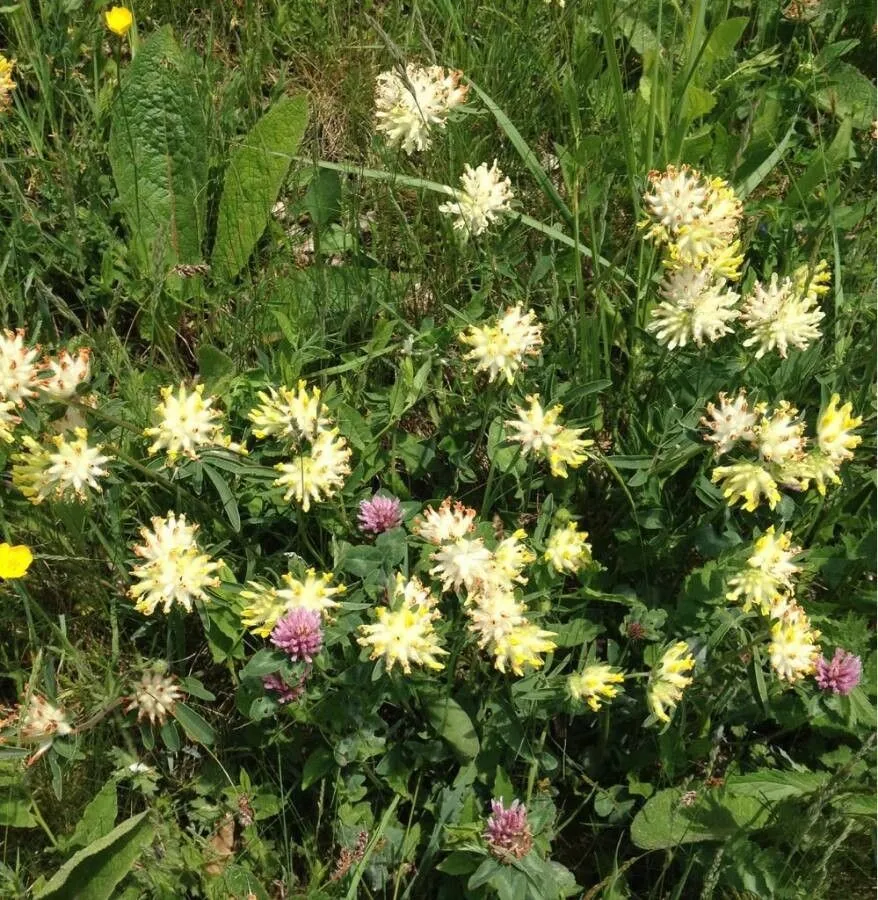
Author: L.
Bibliography: Sp. Pl.: 719 (1753)
Year: 1753
Status: accepted
Rank: species
Genus: Anthyllis
Vegetable: False
Observations: Europe to Iran, N. & NE. Trop. Africa
Kidney-vetch, scientifically known as Anthyllis vulneraria, is a remarkable plant belonging to the Fabaceae family. First described in the seminal work “Species Plantarum” in 1753 by the renowned botanist Carl Linnaeus, this species has captivated botanists and nature enthusiasts for centuries.
The natural habitat of Kidney-vetch spans a diverse geographic range, extending from Europe all the way to Iran, and even finding a foothold in the northern and northeastern tropical regions of Africa. This broad distribution illustrates the plant’s adaptability to various climatic conditions and terrains.
Kidney-vetch is easily recognizable by its distinctive, vibrant yellow flower heads that cluster on long stalks. These flowers not only add a splash of color to their surroundings but are also important for local pollinators, such as bees, which rely on them for nectar. The plant’s leaves are equally notable, pinnate in structure, and often covered with soft, silky hairs that give a silvery appearance, adding to its aesthetic appeal.
Beyond its visual charm, Kidney-vetch has a rich history of use in traditional medicine. The name “vulneraria” itself hints at its medicinal applications, stemming from the Latin word for “wound healer.” Historically, it was used to treat minor wounds and skin ailments, thanks to its reputed anti-inflammatory and healing properties.
Ecologically, Anthyllis vulneraria plays a significant role in its habitat. As a member of the Fabaceae family, it contributes to soil health through nitrogen fixation. This process enriches the soil with essential nutrients, promoting the growth of other plants and maintaining ecosystem balance.
Efforts to conserve Kidney-vetch are crucial, given its extensive yet fragmented distribution. Protecting this species ensures the preservation of not just a single plant, but the myriad of organisms and ecological interactions that depend on it.
In gardens and landscapes, Kidney-vetch is valued for its hardy nature and minimal maintenance needs. Its ability to thrive in poor soils makes it an excellent choice for challenging garden spots. Whether cultivated for its beauty, its ecological benefits, or its historical medicinal use, Kidney-vetch remains a plant of significant interest and value.
Fin: (euroopan)masmalo
Swe: (euroopan)masmalo, getväppling
Eng: common kidneyvetch, kidney vetch, kidney-vetch, lady’s-fingers, woundwort, common kidney-vetch, lady’s fingers
Deu: gemeiner wundklee, gewöhnlicher wundklee, tannenklee, wundklee
Dan: gul rundbælg, rundbælg
Fra: anthyllide vulnéraire, anthyllis vulnéraire, trèfle jaune des sables, vulnéraire
Ita: antillide, erba vulneraria, vulneraria
Spa: hierba llaguera, vulneraría
Nob: rundbelg
Nno: rundskolm
Cat: vulnerària
Nld: wondklaver
Cym: meillionen felen, plucen, plucen felen, pupus melyn, pys yr aren
Tur: coban gulu
Gla: méara muire
En: Kidney-vetch, Woundwort, Lady’s-fingers, Lady fingers, Wound-wort, Common kidneyvetch, Kidney Vetch, Common kidney-vetch, Lady’s fingers, Lady’s-finger
Ca: Vulnerària
Cs: Úročník bolhoj
Da: Gul rundbælg, Rundbælg
Nl: Wondklaver
Fi: (euroopan)masmalo
Fr: Anthyllide vulnéraire, Anthyllis vulnéraire, Trèfle jaune des sables, Vulnéraire, Triolet jaune, Arnica, Trèfle des sables, Trèfle jaune
De: Wundklee, Tannenklee, Gemeiner Wundklee, Gewöhnlicher Wundklee, Echter Wundklee, Wundkraut
It: Antillide, Erba vulneraria, Vulneraria, Vulneraria comune
Nb: Rundbelg
Nn: Rundskolm
Gd: Méara muire
Sk: Bôľhoj lekársky
Es: Hierba llaguera, Vulneraría, Vulneraria
Sv: Getväppling, (euroopan)masmalo
Tr: Coban gulu
Cy: Meillionen Felen, Plucen, Plucen Felen, Pupus Melyn, Pys yr Aren
Taken Oct 28, 2017 by Mio Cri (cc-by-sa)
Taken Apr 8, 2018 by Heinz Gass (cc-by-sa)
Taken May 18, 2018 by Dieter Wagner (cc-by-sa)
Taken May 14, 2017 by Yannick Chevrier (cc-by-sa)
Taken May 23, 2017 by Bernard Sudan (cc-by-sa)
Taken Sep 9, 2021 by Jacques Zuber (cc-by-sa)
Taken May 21, 2020 by Denis Barron (cc-by-sa)
Taken Jun 28, 2021 by Alain Bigou (cc-by-sa)
Taken May 18, 2018 by Dieter Wagner (cc-by-sa)
Taken May 18, 2018 by Dieter Wagner (cc-by-sa)
Taken Mar 16, 2022 by vero (cc-by-sa)
Taken Jun 28, 2021 by Alain Bigou (cc-by-sa)
Taken Jul 5, 2018 by Fejul Xeto (cc-by-sa)
Taken Jun 12, 2018 by Marcos Rivas Campoamor (cc-by-sa)
Taken May 18, 2018 by Dieter Wagner (cc-by-sa)
Taken Jul 31, 2022 by Tristan Jaton-Maria (cc-by-sa)
Taken Jul 3, 2018 by Pep Secem (cc-by-sa)
Taken Jul 3, 2018 by Pep Secem (cc-by-sa)
Taken Jul 3, 2018 by Pep Secem (cc-by-sa)
Taken Jul 3, 2018 by Pep Secem (cc-by-sa)
Taken May 15, 2009 by Photoflora – Benoit BOCK (©)
Taken May 5, 2022 by Pierre LEON (cc-by-sa)
Taken Apr 15, 2022 by Pierre LEON (cc-by-sa)
Taken Jul 31, 2022 by Tristan Jaton-Maria (cc-by-sa)
Taken Jun 12, 2018 by Marcos Rivas Campoamor (cc-by-sa)
Taken Nov 2, 2016 by Yoan MARTIN (cc-by-sa)
Taken Nov 2, 2016 by Yoan MARTIN (cc-by-sa)
Taken Jul 2, 2014 by Tela Botanica − Pascal HAVET (cc-by-sa)
Taken Apr 4, 2022 by huy HO (cc-by-sa)
Taken Jun 29, 2022 by Easger (cc-by-sa)
© copyright of the Board of Trustees of the Royal Botanic Gardens, Kew.
© copyright of the Board of Trustees of the Royal Botanic Gardens, Kew.
© copyright of the Board of Trustees of the Royal Botanic Gardens, Kew.
Growth habit: Forb/herb
Ph maximum: 7.5
Ph minimum: 7.0
Light: 8
Atmospheric humidity: 4
Bloom months: [‘may’, ‘jun’, ‘jul’, ‘aug’]
Soil nutriments: 2
Family: Myrtaceae Author: (F.Muell.) K.D.Hill & L.A.S.Johnson Bibliography: Telopea 6: 402 (1995) Year: 1995 Status:…
Family: Rubiaceae Author: Pierre ex A.Froehner Bibliography: Notizbl. Bot. Gart. Berlin-Dahlem 1: 237 (1897) Year:…
Family: Sapindaceae Author: Koidz. Bibliography: J. Coll. Sci. Imp. Univ. Tokyo 32(1): 38 (1911) Year:…
Family: Asteraceae Author: A.Gray Bibliography: Pacif. Railr. Rep.: 107 (1857) Year: 1857 Status: accepted Rank:…
Family: Fabaceae Author: Medik. Bibliography: Vorles. Churpfälz. Phys.-Ökon. Ges. 2: 398 (1787) Year: 1787 Status:…
Family: Aspleniaceae Author: (Cav.) Alston Bibliography: Bull. Misc. Inform. Kew 1932: 309 (1932) Year: 1932…